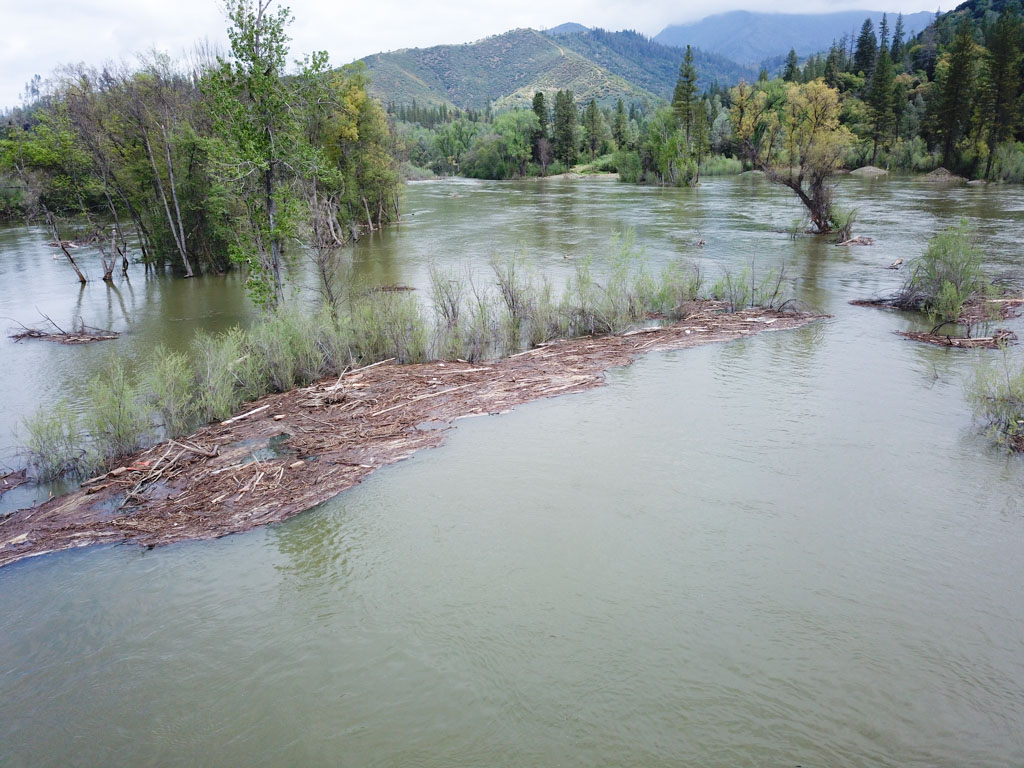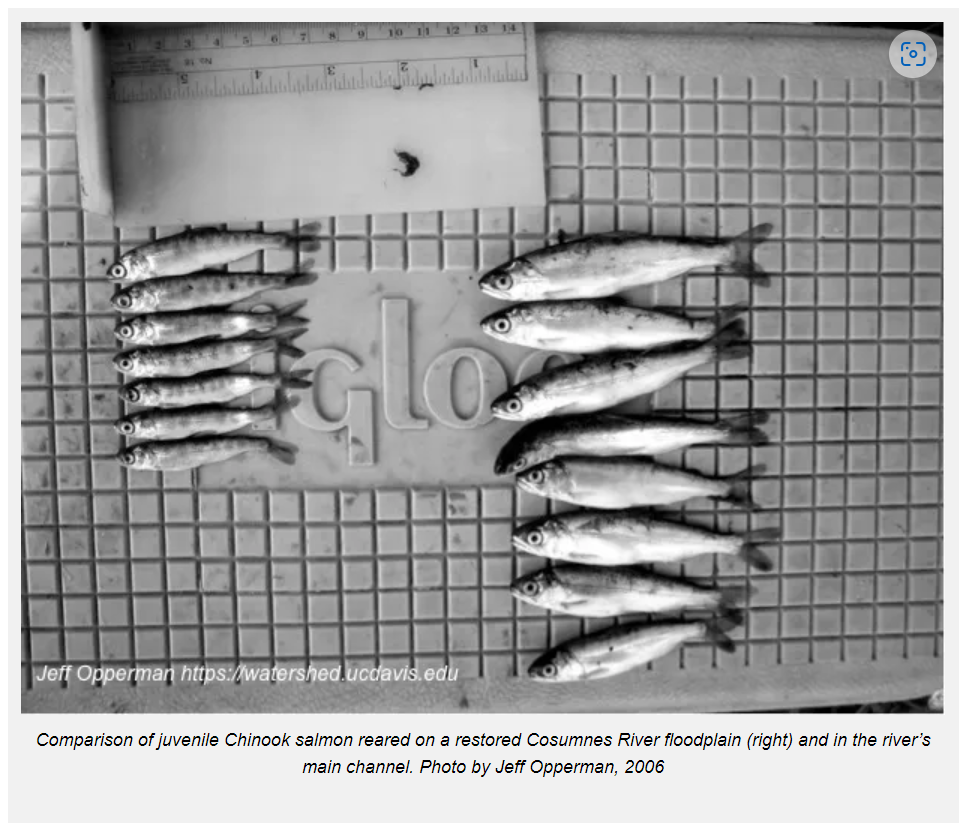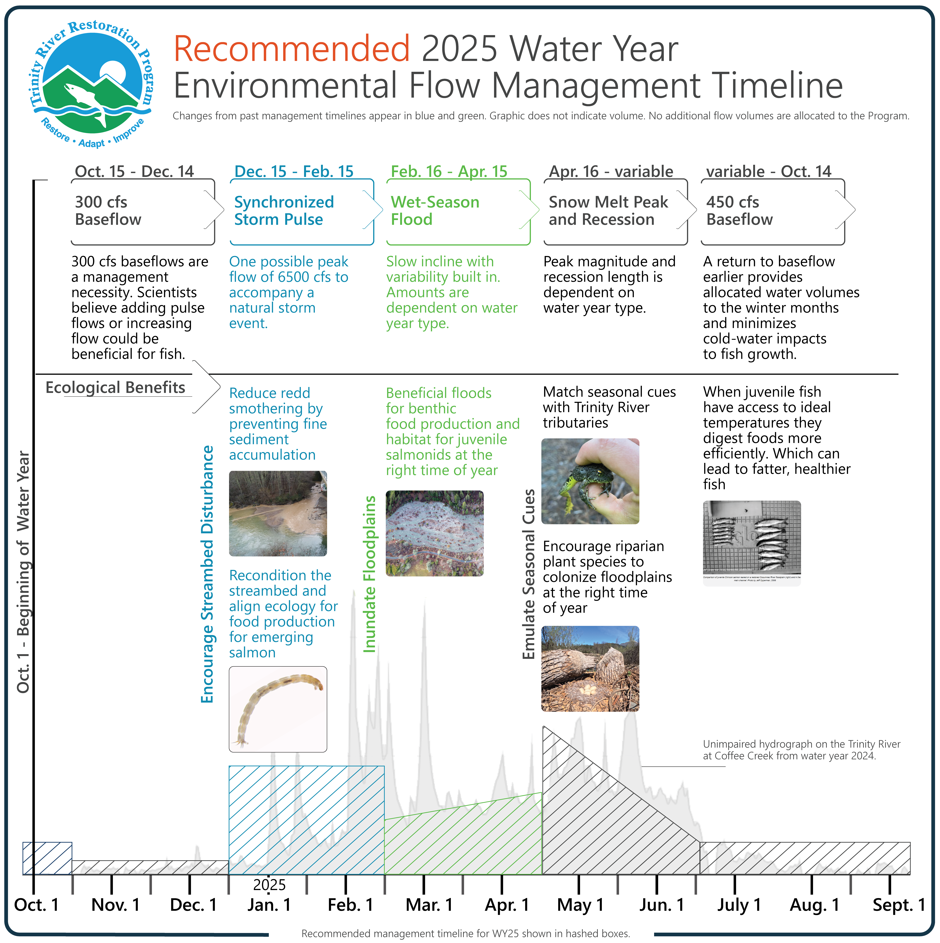
Prior to construction of dams on the Trinity River, flow and river temperatures were synchronized throughout the watershed with seasonal ecology. Storms and snow melt floods regularly altered the stream channel, transporting sediments, wood and rocks. Seasonally predictable disturbance helped maintain a healthy streambed and riparian forest. Disturbance was followed by growth, with wetted areas providing consistent habitat for insects, fish and frogs alike. Even though each year provided different conditions, there was predictability with which aquatic and riverine species, like salmon, evolved to exploit.
Since the foundational 1999 Trinity River Flow Evaluation Report, more than 20 years of scientific research within the Trinity River Basin and from rivers across the world have improved outcomes for Trinity River salmonids. This wealth of new and improved knowledge has made scientists within the Program increasingly aware that changes to flow management have the potential to increase the strength and resiliency of juvenile salmonids produced in the Trinity River.

One important revelation is that elevated releases that continue through late spring and into the summer have kept water too cold for optimal juvenile salmon growth. Larger fish have a better chance of survival in the ocean, so improved flow management that can provide better temperatures for growth is likely to improve survival and subsequent adult returns. Further, Program scientists have found that the majority of young Chinook Salmon have already left the restoration reach by the time elevated spring releases provide access to restored habitats created by the Program over the last 18 years, including floodplains and side channels.
Many studies have shown that when floodplains and side channels get wet at the right time of year when juvenile salmon can use them, then they can take advantage of all the extra food that those habitats create. When fish can access important habitat, increase their food consumption, and have the right temperatures for growth, they can grow faster, get bigger, and survive better.
Recommendations for Change
Changes to Trinity River flow management to partially mimic the seasonality of natural flow were approved by the Trinity Management Council this past September. Program partners in our Flow Workgroup technical advisory committee developed a collaborative proposal that met ecological objectives and accommodated recreational considerations requested by Trinity County. The proposal also needed to adhere to existing environmental regulations. Following the affirmative Trinity Management Council vote in September, the recommendation is now awaiting approval by the U.S. Department of the Interior.
Water Year 2025 environmental flow management is designed to partially mimic natural seasonality so that river ecology can build around flow as it did prior to dams. These managed flows do not strictly follow the natural ecology of the watershed, but rather they represent management that strikes a balance between ecological needs, water availability, and other management and infrastructure constraints. Scientists hypothesize that adding pulse flows, increasing flow in winter, and decreasing flow in the spring and summer could be beneficial to Trinity River salmonids. However, there is no recommendation for this water year to reduce minimum baseflows in summer or fall.
First Recommended Change: Synchronized Storm Pulse
The first recommended sequential change is the two-month Synchronized Storm Pulse period (December 15-February 15) where there may be one peak flow of 6,500 cubic feet per second released from Lewiston Dam timed to match a natural storm event. This synchronized flow would consist of a rapid flow increase release held for a short period then reduced to 750 cubic feet per second. A synchronized storm pulse would only be triggered if the river is predicted to be at least 4,500 cubic feet per second near the North Fork Trinity River. No synchronized release would occur if the river is not predicted to reach that level between December 15 and February 15.
Winter storm pulses provide many ecological benefits, primarily by causing streambed disturbance. Sediments ranging in size from sand to large gravel are displaced and moved downstream, and wood in the channel can be moved or cause erosion in the channel that increases habitat diversity. Fine sediments rich in nutrients are also washed onto upland riparian areas that are typically dry. As waters recede, nutrients remain to help develop a healthy riparian community of plants and animals. For salmon, the disturbance from big powerful storms provides opportunity for small, soft-bodied bugs to proliferate, which are an excellent food source for small juvenile salmonids as they emerge from the gravel.

Since 1960’s, with very few exceptions, typical winter flow releases from Lewiston Dam have remained under 300 cubic feet per second. When big storms pass through, tributaries deliver trees, nutrients, and all sizes of sediment, which enter the Trinity River where flows are artificially low due to limited dam releases. Often there is not enough flow in the Trinity River to move these deliveries from tributaries, so they settle out quickly. Where Deadwood Creek enters the Trinity River, large fine sediment deposits from the 2018 Carr fire have immediately settled into slow waters in recent years resulting in two negative effects. First, the tributary delta has formed unnaturally, and second fine sediments have smothered and suffocated salmon and steelhead eggs in the gravel.

Second Recommended Change: Wet-Season Flood
The second recommended change is the two-month (February 16 – April 15) Wet-Season Flood period, during which dam releases would be elevated above the typical 300 cfs baseflow with some variability. The amount of water released during this period depends on seasonal snow and rain accumulation and a conservative forecast of inflow to Trinity Reservoir from the California Department of Water Resources (90% B120).
These beneficial floods push water onto floodplains and keeps them wet for months, which essentially converts terrestrial habitat into aquatic habitat just as salmon and steelhead begin to emerge from the gravel and populations increase. This seasonal aquatic habitat grows food for fish and provides slow water habitat for small fish to rest, grow, and escape many aquatic predators.

Snow Melt Peak and Recession
The Snowmelt Peak and Recession period has been implemented on the Trinity River for the past 20 years. The action provides important migration cues for adult and juvenile salmonids. Peak flows can provide many of the benefits that winter storm pulse flows provide earlier in the year, resetting the base of the food web and delivering nutrients to riparian areas. Receding flows trigger spring Chinook Salmon returning from the ocean to migrate toward over-summer habitat. Additionally, juvenile salmon and steelhead migrate out of rivers, to the ocean, as habitat availability decreases with dropping flows.
Proposed changes to flow management in 2025 would use the same volume of water that has been available since 2000, so any water released for a synchronized storm pulse or wet season flood would be borrowed from the spring snow melt release. As a result, releases would slow earlier, reducing cold-water impacts to fish growth while providing ecological benefits earlier in the year. Adjustments to flow management that more closely align dam releases with natural ecological processes are intended to also benefit other aquatic and semi-aquatic species, such as Foothill Yellow Legged frogs and Northwestern Pond turtles.
As mentioned, the recommendations presented for water year 2025 are designed to partially mimic natural seasonal processes so that ecological function can develop on the seasonal timeline, as it did for millennia prior to dam construction. Program scientists have long known that these recommended changes are necessary for making progress toward producing stronger healthier Trinity River fish populations.
If changes are approved by the Department of the Interior, the Trinity River Restoration Program will announce details regarding; flow action changes, ways to stay informed and notification timelines as they develop.
Ways to stay informed
Join the Trinity Releases email group
Follow our Facebook page
Join the TRRP newsletter email group
If you have questions, please contact the Trinity River Restoration Program office at 530/623-1800 or by emailing your question to info@trrp.net.


